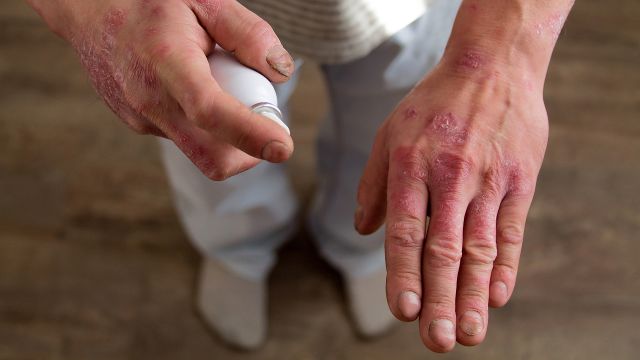Updated on March 22, 2023
Psoriasis is a chronic skin disorder. In its most common iteration—plaque psoriasis—it causes lesions called plaques, which are inflamed patches of skin. On lighter skin, these patches can appear thickened and reddish or salmon-colored, with a silvery or white scaled texture. On darker skin, they may look violet or darker brown, and the scales may be grayish.
Other types of psoriasis cause other symptoms, ranging from pustules (pustular psoriasis), to small round spots (guttate psoriasis), to shiny lesions in the folds of skin (inverse psoriasis), to inflammation that is widespread, severe, and potentially life-threatening (the rare, but very serious, erythrodermic psoriasis).
All types of psoriasis are associated with immune system abnormalities, where immune cells speed up the growth of skin cells. There is no cure for psoriasis, but there are a number of treatments available, and many people living with psoriasis are able to achieve clear or clearer skin.
A variety of topical treatments, UV light therapy, immunosuppressant drugs, and biologic therapies that act on the immune system are all used in the treatment of psoriasis. Treatment typically depends on a number of factors concerning the psoriasis and the patient. One of those factors is the severity of symptoms.
Psoriasis is classified as either mild, moderate, or severe. There are several criteria that are used in determining the severity. These include the percentage of the body’s surface area that is affected by psoriasis, the intensity of symptoms, the areas of the body affected, and the impact that psoriasis has on a person’s quality of life.
Surface area, intensity, location
Psoriasis is classified as mild, moderate, or severe, depending on how much of the body it covers. For scope, 1 percent of the body is roughly equal to the surface area covered by one hand.
- Psoriasis that affects less than 3 percent of the body’s surface area is considered mild.
- Psoriasis that affects between 3 and 10 percent of the body is considered moderate.
- Psoriasis that affects more than 10 percent of the body is considered severe.
Psoriasis that affects a smaller area of the body may be considered more severe if the symptoms are more intense—for example, if the plaques are very thick, painful, and itchy. Even psoriasis that affects only a small area of the body—such as a highly visible area like the scalp, or very sensitive area like the genitals—can cause a significant amount of distress, and can be considered more severe.
Quality of life
Any disease that affects appearance can have a significant negative impact on a person’s mental and emotional well-being, and psoriasis is no exception. Many people with psoriasis report feelings such as anxiety, distress, and low self-worth tied to their psoriasis symptoms. People with psoriasis are also more likely to experience mood disorders like depression and anxiety.
These feelings can be due to the stigma of having a skin condition (even one that is not contagious, such as psoriasis), the frustration of having to manage symptoms like itching and pain, and the challenges psoriasis poses to everyday things like work and intimate relationships.
Other psoriatic disease
Under the broader umbrella of psoriatic disease, there is also psoriatic nail disease (PND) and psoriatic arthritis.
PND changes the appearance and texture of nails on the fingers and toes, and causes nails to become fragile and easily damaged. It can make working or performing tasks with the hands painful and difficult.
Psoriatic arthritis is a type of arthritis that affects people with psoriasis. In psoriatic arthritis, immune system abnormalities cause inflammation in the joints, resulting in joint pain, swelling, and stiffness. About 30 percent of people with psoriasis develop psoriatic arthritis, and some develop psoriatic arthritis before psoriasis.
Symptoms of both PND and psoriatic arthritis should be discussed with a healthcare provider, and should be considered when making treatment decisions.






